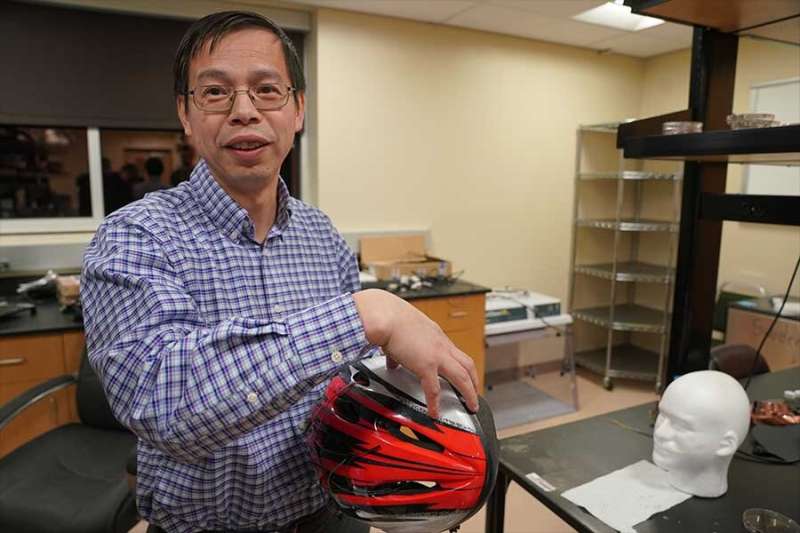Developing the spacesuit of the future

Researchers at South Dakota School of Mines & Technology have entered their third year of development of a wearable and wireless body sensor system—with the ability to be powered remotely—that will revolutionize NASA spacesuits.
NASA has set a lofty goal of human travel to Mars by 2030. In order to meet this goal, better spacesuits are essential, says Dr. Sayan Roy, assistant professor in electrical engineering at South Dakota Mines and a member of the research team. "One of NASA's strategic goals is to send astronauts into deep space for future exploration missions. The dangerous and unfriendly space environment dramatically affects astronauts' health status. To ensure astronauts' health and safety, NASA is taking actions to minimize the negative effects of space travel on the human body," he says. "There is a need for innovation in space suit design."
Roy says the research "fits seamlessly with the priorities in NASA's Human Exploration and Operations Mission Directorate and the Space Technology Mission Directorate. This project is closely relevant to NASA's Technology Roadmap TA 6: Human Health, Life Support and Habitation Systems."
While in space, the health of astronauts is closely monitored from Earth. Vitals such as heart rate, blood oxygen level, blood pressure, breathing volume and skin temperature are tracked, as is the movement of each astronaut. Currently, health information is tracked through wired sensors inside spacesuits. The wired system makes spacesuits heavy and cumbersome. The current technology is also difficult to troubleshoot in case of any malfunction, Roy says.
The sensors in development at Mines would allow for suits that are sleeker and lighter with a wireless network of sensors that will capture and transmit the health data of astronauts in real-time. Made of carbon fiber material, the wireless sensors will allow for much more flexibility in spacesuit design.
This multi-disciplinary and multi-institution research project is funded through NASA EPSCoR, a funding program encouraging partnerships between government, higher education and industry. The $750,000 grant began in January 2018 and ends December of this year.
The wireless sensor project also involves researchers from two additional South Dakota universities—University of South Dakota and South Dakota State University, as well as collaborators at four NASA research centers and three industry partners.
On the Mines campus, Roy is joined in the project by Dr. Zhengtao Zhu, an associate professor of chemistry, biology and health sciences; Dr. Edward Duke of the South Dakota Space Grant Consortium and a Mines professor of geology and geological engineering; Dr. Hao Fong, a professor of chemistry, biology and health sciences; and graduate research assistant Ahsan Aqueeb.
Dr. Zhu says developing or finding the right materials for the sensors has been a challenge as they must be compatible with human skin and clothes. "They must be wearable biomedical and strain sensors that are lightweight, comfortable, flexible and stretchable," he says. While some of the sensors will be inside the spacesuit, others will be applied directly to the skin.
While the sensors will communicate critical physical health information to the NASA experts on Earth, sensors might also have the capability to monitor mental health and even "be able to understand behaviors." For instance, an astronaut's physical behavior could trigger a sensor to recognize anything from depression to an injury, relaying that information to NASA experts.
The sensors will also be able to communication with each other, Roy says. Because accurate health monitoring of astronauts is critical, the system must be fail-proof. If one sensor fails, the system must be designed in a way that the failed sensor can be identified by the other sensors and bypassed, says Aqueeb. "No matter what happens, it cannot fail," he said. "We cannot lose any data."
The sensors also must be secure with proper encryption to prevent interference or hacking, a portion of the project overseen at SDSU.
Perhaps most challenging, the wireless nodes must be charged without the benefit of a physical connection to a power source. A wireless power transfer system is designed to transfer power from one "electrical network to another" without the benefit of a wire or a physical connection of any kind. While wireless power transfers are not new, "far field" transfers such as from a centralized power source located at a nearby space station is a newer and more significant challenge. At the same time, the far field transfers will also have to be of a higher level of power than ever required before.
"How do we distantly transfer the wireless power in free space with higher efficiency?" Roy asks. The sensors must be designed to "sense" the power as it is transferred. The power transfer needs to be safe for the human body, as the sensors are close to the body and sometimes applied to the skin. Such technology will need to be unfailingly consistent, approved by such agencies as the FCC and safe for humans. "We have a lot of variables," Roy says. "These are the challenges."
Once developed, such far field power transfers could be utilized in other areas outside of space travel, from precision agriculture to maintaining contact with underground miners. But for now, the focus is on the next generation of space suits.
Provided by South Dakota School of Mines & Technology




















